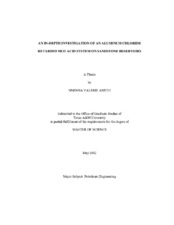| dc.contributor.advisor | Nars-El-Din, Hisham | |
| dc.creator | Aneto, Nnenna | |
| dc.date.accessioned | 2012-07-16T15:57:42Z | |
| dc.date.accessioned | 2012-07-16T20:23:03Z | |
| dc.date.available | 2014-09-16T07:28:18Z | |
| dc.date.created | 2012-05 | |
| dc.date.issued | 2012-07-16 | |
| dc.date.submitted | May 2012 | |
| dc.identifier.uri | https://hdl.handle.net/1969.1/ETD-TAMU-2012-05-10779 | |
| dc.description.abstract | Sandstone acidizing using mud acid is a quick and complex process where dissolution and precipitation occur simultaneously. Retarded mud acids are less reactive with the rock reducing the reaction rate hence increased penetration into the formation to remove deep damage.
To understand thoroughly the retarded mud acid system, an in-depth investigation of the reaction of HF (hydrofluoric) and H2SiF6 (fluorosilic acid) with alumino silicates and the retarded system is undertaken using coreflood analysis and mineralogy analysis using the inductively coupled plasma.
Coreflood analysis is used to understand and investigate the permeability changes in the sandstone rock as the retarded mud acid is injected at different conditions and the inductively coupled plasma (ICP) is used to investigate the effluent samples from the coreflood analysis to properly understand this system.
Several issues that have not been addressed previously in literature are identified and discussed, including an optimum flowrate when sandstone is acidized, by acidizing the sandstone rock with a retarded acid system at various flowrates and determining the initial and final permeabilities. Also investigated is the retarded acids compatibility with ferric iron and a comparison of the retarded acid system to regular acid to consequently enable a thorough understanding of the retarded mud acid system using aluminum chloride (AlRMHF).
Based on the work done, it is found that the absence of a hydrochloric (HCl) preflush is very detrimental to the sandstone core as calcium fluoride is precipitated and the retarded acid system is found to be compatible with iron(III) as an impurity. The regular acid (RMHF) dissolves considerably more silicon and produces more fines than the AlRMHF.
1cc/min is found to be the optimum flowrate when a sandstone core is acidized with AlRMHF. At this low flowrate, less silicon is dissolved, more aluminum is seen in the effluent and more calcium is dissolved. The retarded aluminum acid system considerably reduces the rate of reaction as evidenced in the dissolution reaction when compared to a regular mud acid system. This reduced rate of reaction implies deeper acid penetration and ultimately deeper damage removal. | en |
| dc.format.mimetype | application/pdf | |
| dc.language.iso | en_US | |
| dc.subject | Aluminum chloride retarded mud acid | en |
| dc.subject | Regular mud acid | en |
| dc.subject | Half regular mud acid | en |
| dc.subject | Inductively coupled plasma | en |
| dc.subject | Hydrochloric acid | en |
| dc.subject | Hydrofluoric acid | en |
| dc.subject | Aluminum chloride | en |
| dc.subject | Coreflood | en |
| dc.title | An In-depth Investigation of an Aluminum Chloride Retarded Mud Acid System on Sandstone Reservoirs | en |
| dc.type | Thesis | en |
| thesis.degree.department | Petroleum Engineering | en |
| thesis.degree.discipline | Petroleum Engineering | en |
| thesis.degree.grantor | Texas A&M University | en |
| thesis.degree.name | Master of Science | en |
| thesis.degree.level | Masters | en |
| dc.contributor.committeeMember | Schubert, Jerome | |
| dc.contributor.committeeMember | El-Halwagi, Mahmoud | |
| dc.type.genre | thesis | en |
| dc.type.material | text | en |
| local.embargo.terms | 2014-07-16 | |


